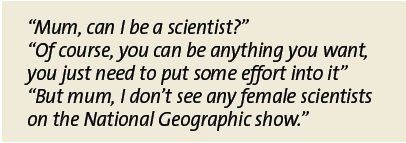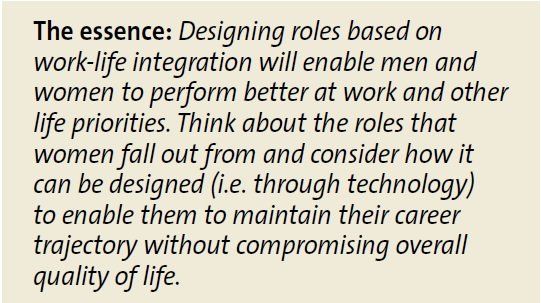Diversity Not Divert-sity That Bridges Gender Gaps

Female population and the system may be putting a stop to their progress

This was an actual conversation I gleaned from one of my interactions with a human resources (HR) leader. Today, diversity is not just data; diversity is evident in stories, in visuals and in everyday life.
We know from data that diversity is a top agenda for most organisations, but does that become a priority in action planning? If we take women in top positions as a yardstick for the success of the diversity agenda, then the underrepresentation of women in boards and top management level indicate that its effectiveness is far from satisfactory.
Data shows that women only make up about 4.6% of chief executive officers (CEOs) in Fortune 500 companies and 16.9% in corporate board positions. Even if we take a wider range of companies, such as the Fortune 1000 companies, it would take an additional 1,400 women for all these boards to have at least three female members according to a McKinsey quarterly article in 2013.
In a PricewaterhouseCoopers (PwC) study on Developing tomorrow’s female leaders, it is estimated that female millennials will form at least a quarter of the global workforce, and the status quo is not likely to help employers attract and retain this talent pool.

Even with diversity initiatives, 29% of the female millennials who participated in the research felt that employers were too biased towards male employees when it came to job promotions. That’s a third of the female population feeling sidelined even with initiatives in place.
What’s worse is when diversity initiatives are used as a ‘Diversity Defence’ so that organisations have minimal accountability when they walk the talk.
Thankfully, not all initiatives end up as ‘window displays’ as there are some that have been proven to help women thrive in their careers. One example are those found in the top 100 companies based on the Diversity Woman Media survey.
Using criteria such as women’s upward mobility, presence of female managers, mentorship programmes and family-friendly policies, these companies were identified as having initiatives that progress the women’s career agenda.
Global management consulting firm A.T. Kearney for example has revamped the old model of consulting and time pressures on women. At Cisco, women are involved in succession planning and make up 75% of the top management) in their finance group, with senior vice president positions particularly common. At global hotel chain Marriott International, 50% of the top salaries go to women.
We are starting somewhere, so how can we move the agenda further and sustain this progression?
Diversity promotes better decisions

We know that there are benefits in having a diverse workforce. The European Commission Factsheet on the ‘Economic Arguments for Women on Boards’ shows that more gender diversity on boards does lead to improved company performance, better mirroring of consumer decisions, better quality decision making, improved corporate governance and ethics and better use of women as talents.
According to Betsy Berkhemer-Credaire, author of The Board Game: How Smart Women Become Corporate Directors, risk aversion could be a key factor for these benefits. A 2012 Credit Suisse study showed that when there is at least one female director on the board, nett-to-debt equity ratio was lower compared to companies who have all-male boards.
I distinctly remember a story from one of the top female CEOs in Malaysia’s finance industry who shared that, in her years being in all-male meetings, she often found herself as the lone member saying: “Wait, let’s take a step back”.
That helped them make the right decisions for the organisation, something she believes is one of the key values that women can bring to the boardroom.
A quick Google search will show you some of the key gender diversity initiatives and best practices around the world but here we can look at three approaches that can help an organisation kick-start its diversity agenda or refine their current model for a sustainable impact.
1. The individual approach: Emotions
Claire Shipman, an ABC news correspondent and author of The Confidence Code, posits that the confidence portrayed by a woman is not necessarily equivalent to Mad Men bravado and ‘playing hero’.
She believes that distinctions in gender exist not only in biological terms but also in management and thinking styles. When a person, regardless of gender cannot be authentic in their style, then it is likely to negate effects of diversity since we all become the same kind of leader or manager.
Hence, it is important to acknowledge these differences and manage the perception that results from these differences. Because diversity is not just about data, common stories we hear are:
“Her family needs her more, let’s not burden her.” “Are you sure we should consider her for that role in Philippines? She is getting married soon right?” “Well, she’s been on flex work, I’m not sure we can say she has contributed as much as the rest of the team.”
And then, even more common are the stories women tell themselves:
“I can’t be a good mother, I’m staying late at the office again.” “If I take that secondment, am I too ambitious?” “I think I should hold my thoughts until someone asks me; it will be more respectful.”
Do women feel safe to share their thoughts and emotions, especially those that diverge from stereotypes? Are we ready to accept a different perspective of how we think a woman’s role should be?
Shame and guilt are the primary emotions that keep many women from leaping onto the diversity bandwagon. Being able to bring concerns to the surface without judgment could be a foundation for the success of diversity initiatives.
Most organisations that promote this form of openness use sponsors, mentors and awareness training, but what about day-to-day engagements? One way to keep the openness on the ground is to encourage frequent and consistent feedback.
In the same research on millennials by PwC, setting clear targets and providing regular future-focused feedback was found to be important to 50% of the respondents. A culture of constant and regular feedback is likely to keep leaders abreast of the challenges women face. It is also a simple enough skill to be adopted by everyone who is not directly championing the diversity agenda.
The essence: Create an environment that allows for regular, consistent feedback to signal psychological safety and direction to women who may feel challenged in the day-to-day work environment. It is also an actionable skill for a majority of firms that have yet to ride on any diversity initiatives.

2. The gender approach: Equity
At this stage of maturity in organisational diversity initiatives, it is worth paying attention to female-orientated initiatives. The #HeForShe campaign by the United Nations Women on gender equality signifies the important role men and women jointly play in advancing the agenda.
Interestingly, two studies by Dover, Major and Kaiser showed that diversity initiatives tended to be perceived as a threat to the majority population (i.e. white males) and, at the same time, do little to make companies fairer.

They speculate that this could be a reason for the lacklustre success of the diversity agenda. When people feel threatened, the likelihood of buy-in decreases and they may be keener to oppose any effort to make the workplace more inclusive.
The coffee house at my office lobby offers a 30% discount to women on Tuesdays. While I have been enjoying it, this gesture has been met with criticism from my male colleagues who feel it is unfair – and I understand why.
Diversity in today’s terms has gone beyond the typical biological connotations or societal role. If we want more women who are mums to come to work, promoting men who are fathers does not help because these men will spend more time at work and much less time at home.
Organisations have involved men as part of diversity through initiatives such as having a male panel at a women’s conference. Very often, we think of the diversity agenda in terms of its role in promoting equality while in reality, it equally covers equity.
Our assumption is that all men want to rise to the top, though this is perhaps a major misconception as many modern men would like to be able to dial back their office hours and spend time with family.
The essence: Equity in this sense means we need to put a spotlight on women’s careers and at the same time remove barriers to men’s opportunities beyond work. Are your diversity initiatives equal or equitable?
Read More: How Leaders Can Create A Collaborative Company Culture


3. The ecosystem approach: Job design
This approach focuses on the ecosystem which means it veers towards the idealistic but can also be more long-term and sustainable. Currently, most ecosystem-orientated practices focus on implementing policies such as flexible working hours, gender quotas for boards and personal development (e.g. MBA scholarship) funds.
The ideal target, though, is to design our jobs to allow for better work-life integration. We know the work-life balance ship has long sailed and the focus is now on healthy integration of work and life. With this in mind, it is likely that future roles will be designed to manage energy rather than time since the number of hours in a day is not changing anytime soon. This healthy level of integration will be more automated with the advent of technology.
For example, one of the professions most likely to be replaced by automation is the accounting industry. For those in the industry, however, rather than a point of anxiety, this should be seen as an opportunity to redesign how we work. AuditFutures, a thought leadership programme of ICAEW in partnership with Finance Innovation Lab, for instance, is studying how future audit firms will look.
They believe a successful firm in the future is likely to focus on entrepreneurial attitude, technology-enabled data and even user-generated content. This is a far cry from our current professional audit firms, which are more regulated and bureaucratic.
Inspired by the design of firms, could we design our jobs to consider human-centred needs regardless of gender? Whether it means integrating automation so that less energy is spent on mindless work or designing a service chain that allows employees to leave at 6pm, a human-centred ecosystem can help sustain our diversity agenda on a broader perspective.
The essence: Designing roles based on work-life integration will enable men and women to perform better at work and other life priorities. Think about the roles that women fall out from and consider how it can be designed (i.e. through technology) to enable them to maintain their career trajectory without compromising overall quality of life.

At a glance
Of course, all this is not going to happen overnight, but we can start now. Imagine the diversity of the future when it is no longer just an agenda. Regardless of where your organisation is on the progress of the women’s diversity agenda, it will always be an intentional choice to focus on the growth of women and, ultimately, the growth of people.
If we are letting our daughters wash dishes at home while our boys kick up their legs in front of the TV, then we cannot expect changes at work. So, as we intentionally decide on our personal choices, these three approaches will hopefully be a good foundation on which to build engaging and sustainable initiatives.
Read More: Developing Nations Through Gender Equity
Functional
Tags: Women & Leadership, HR, Culture






